Charles E W Bean, Diaries, AWM38 3DRL 606/228/1 - Folder - Part 9
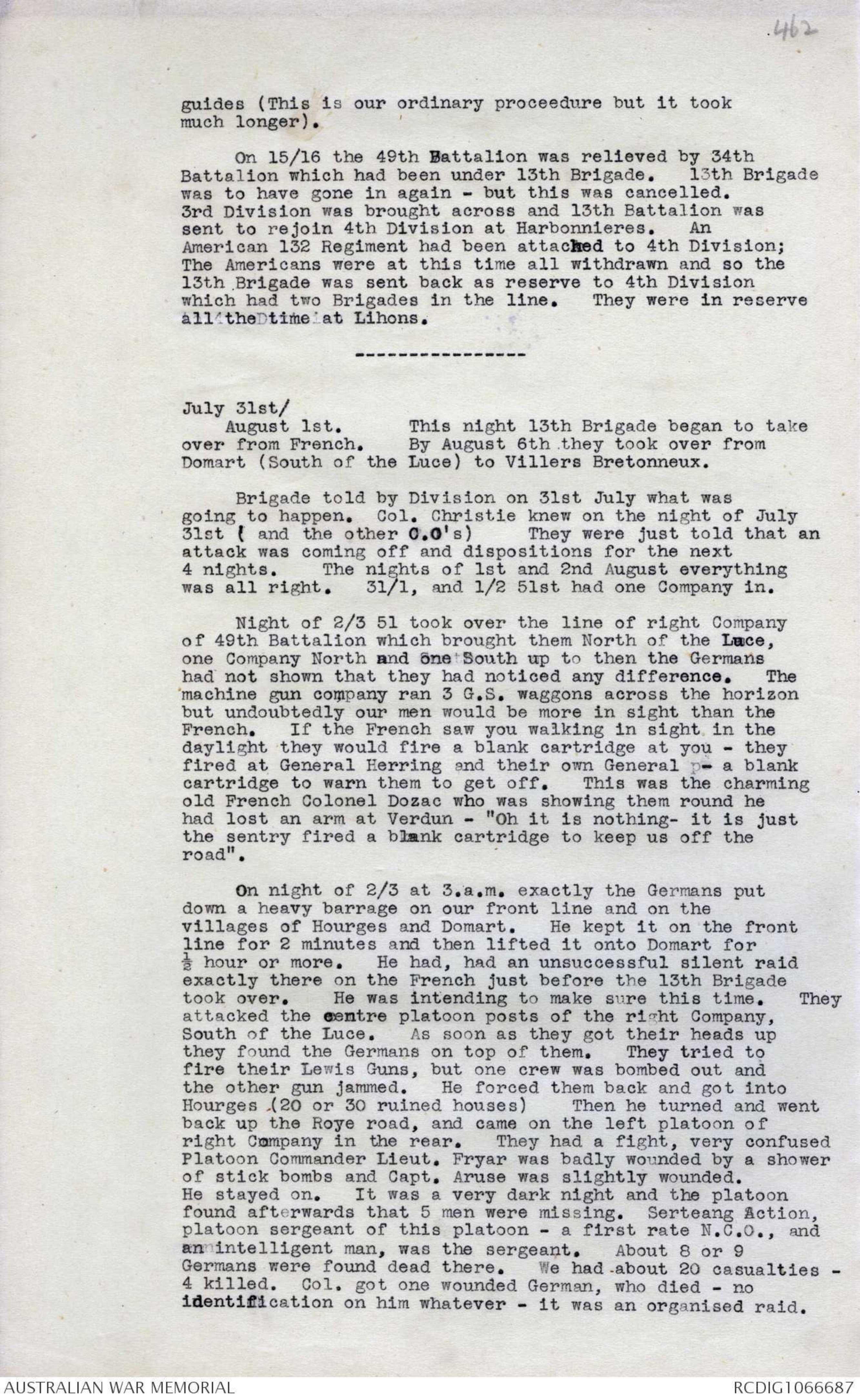
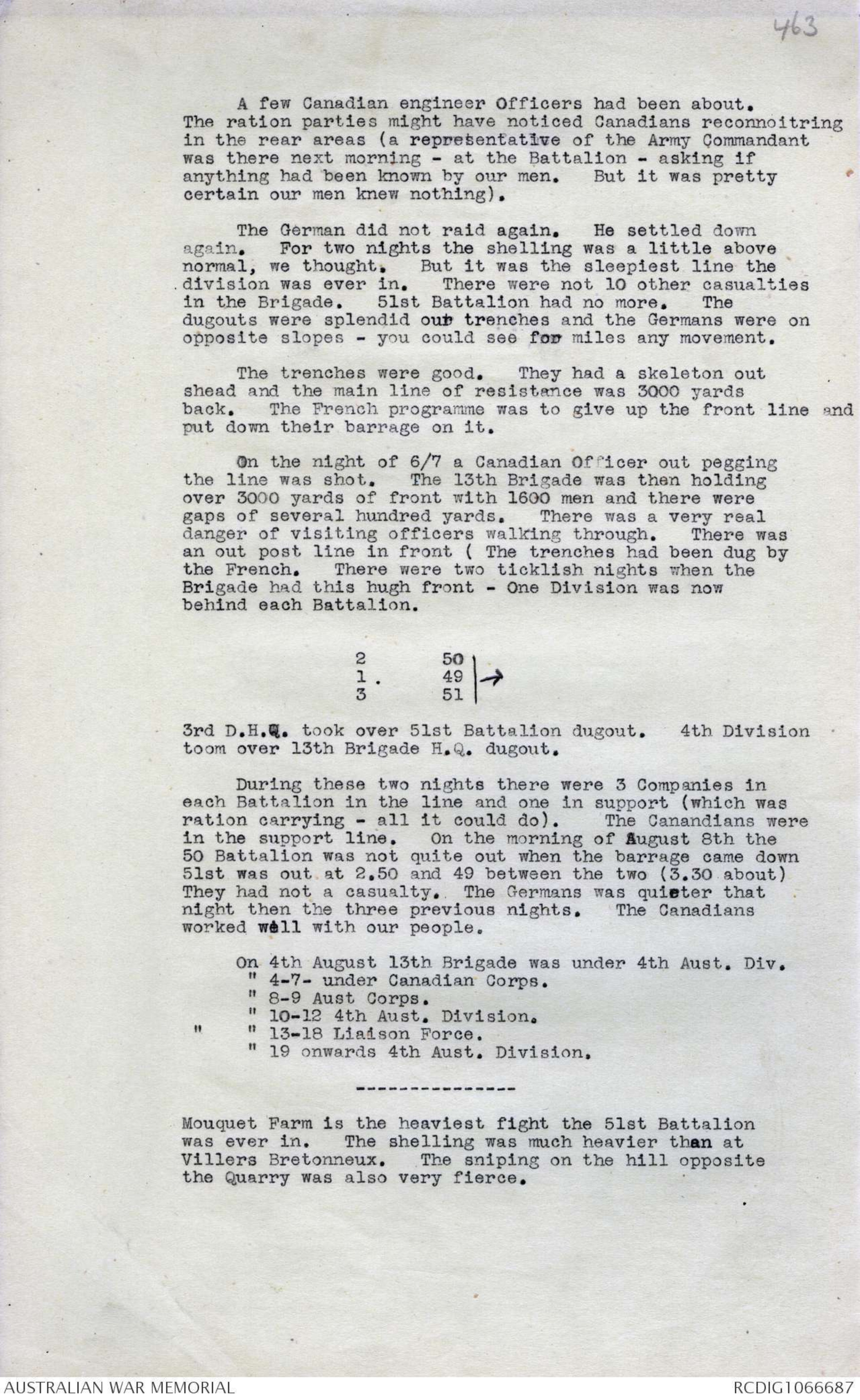
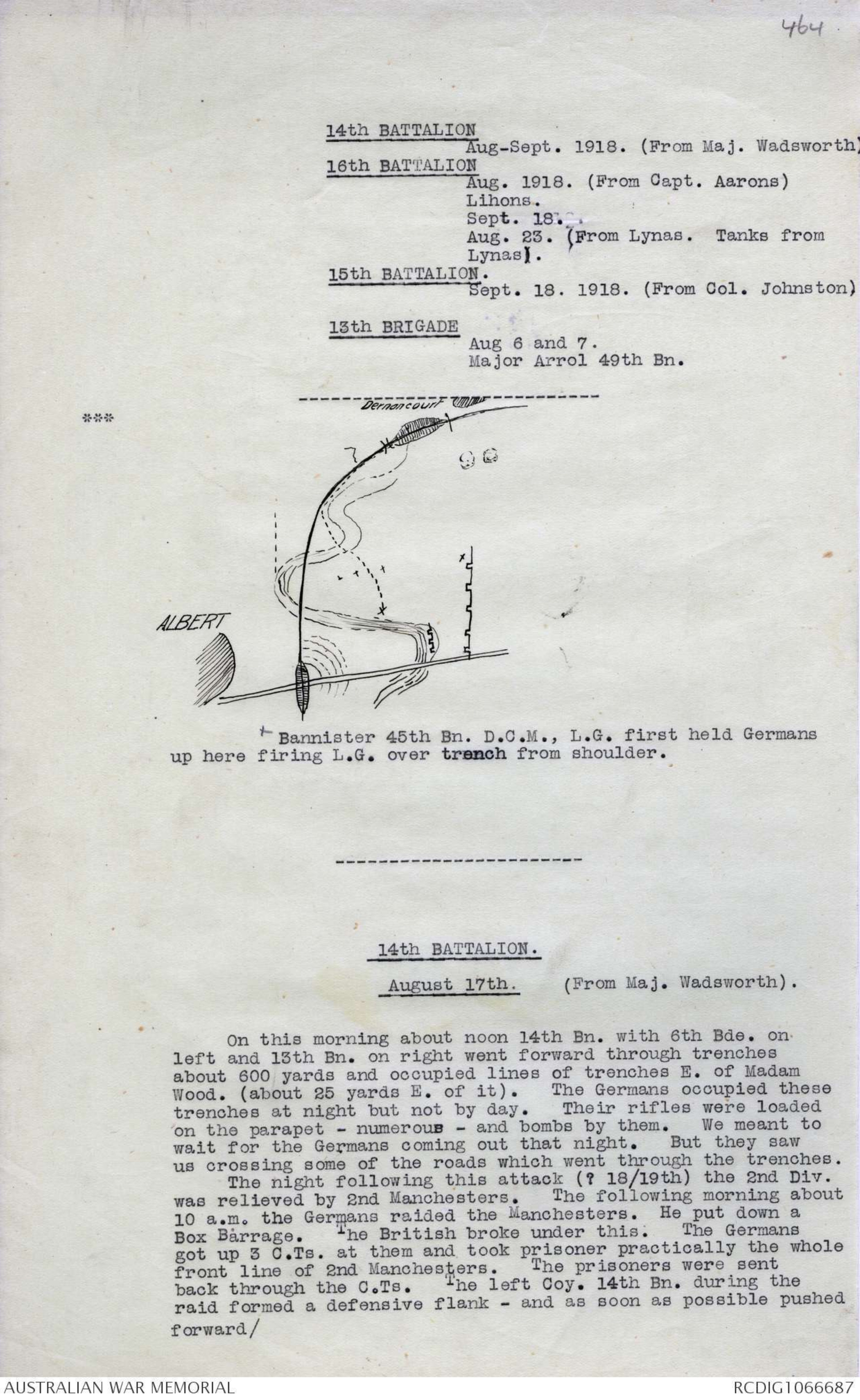
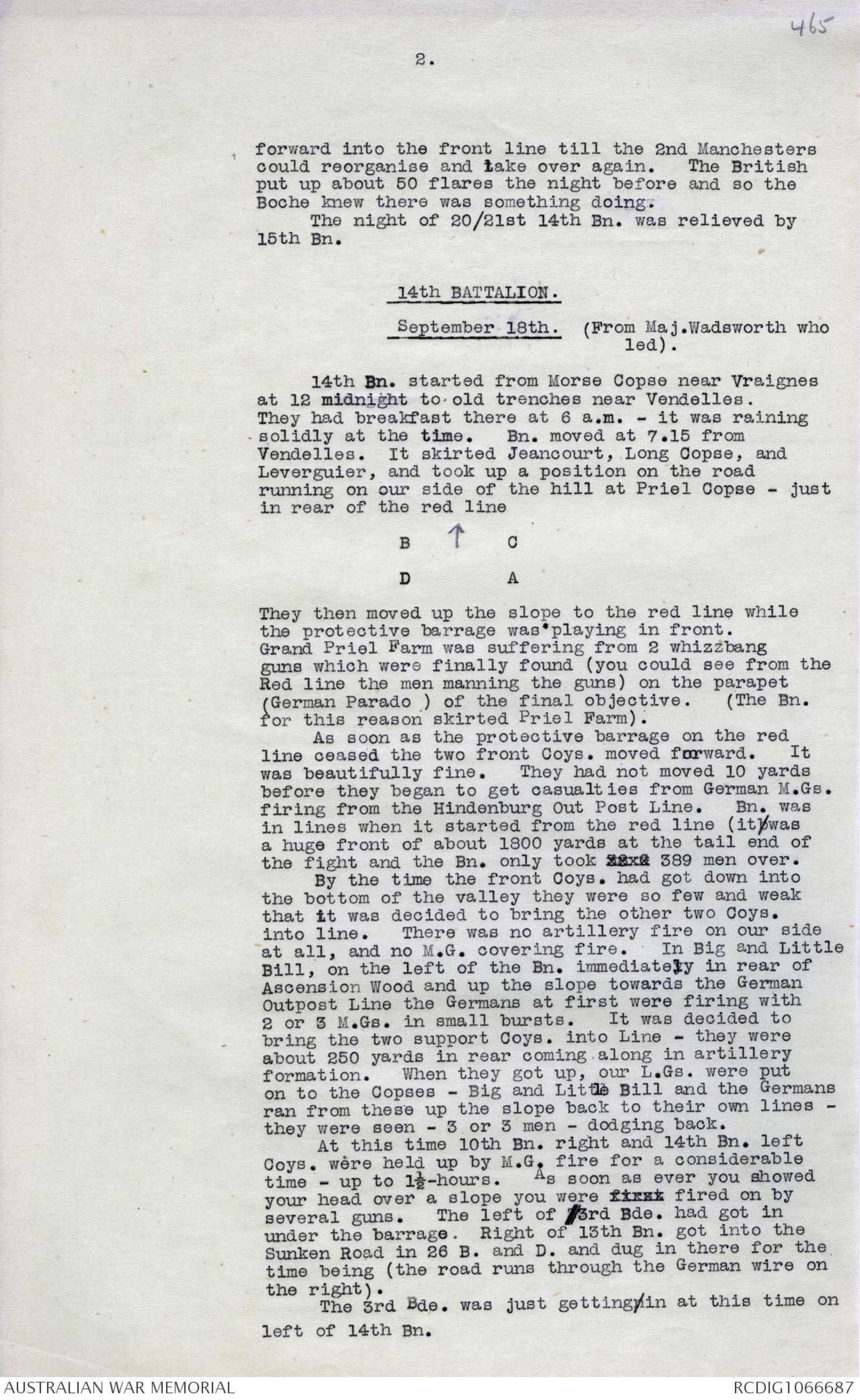
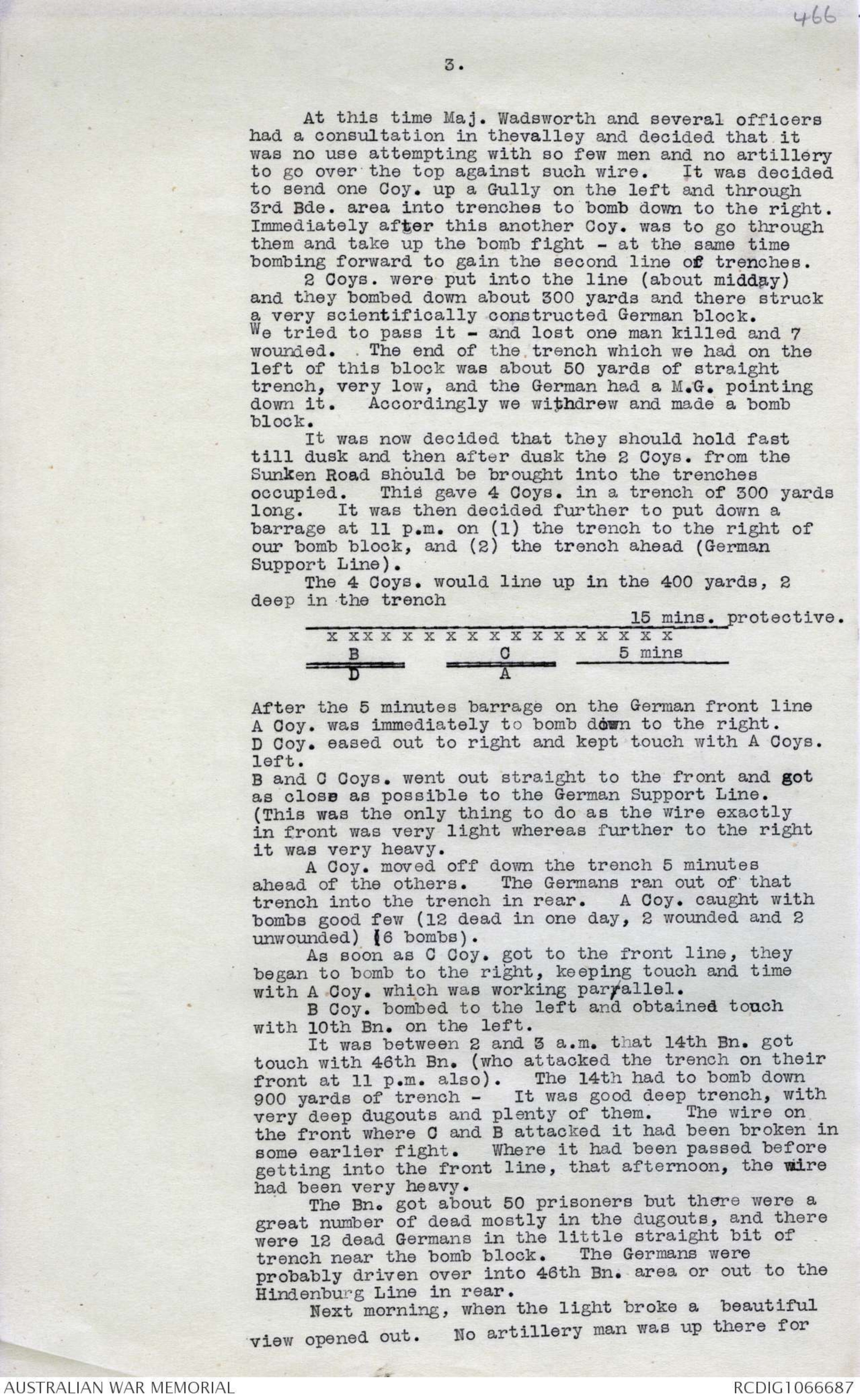
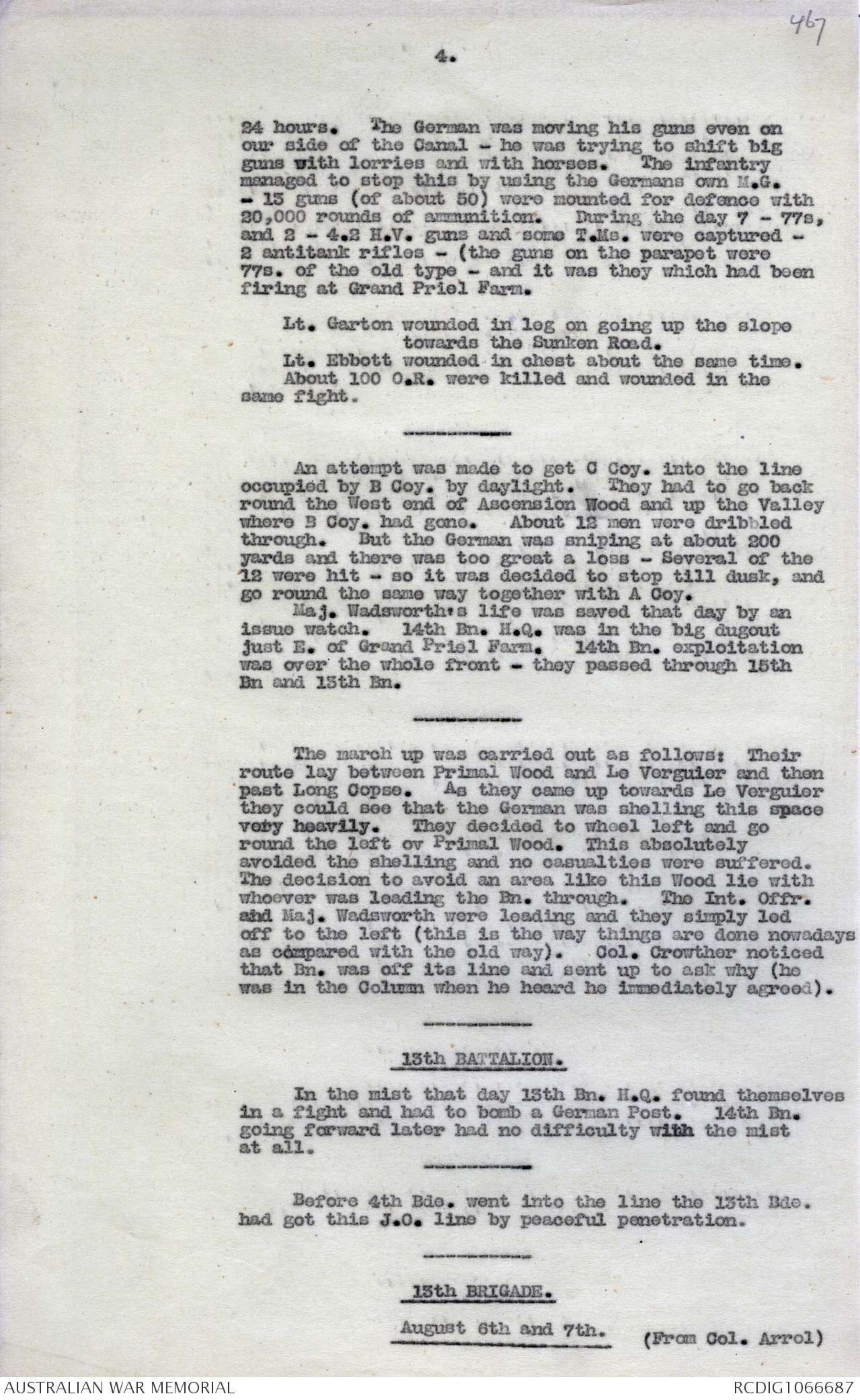
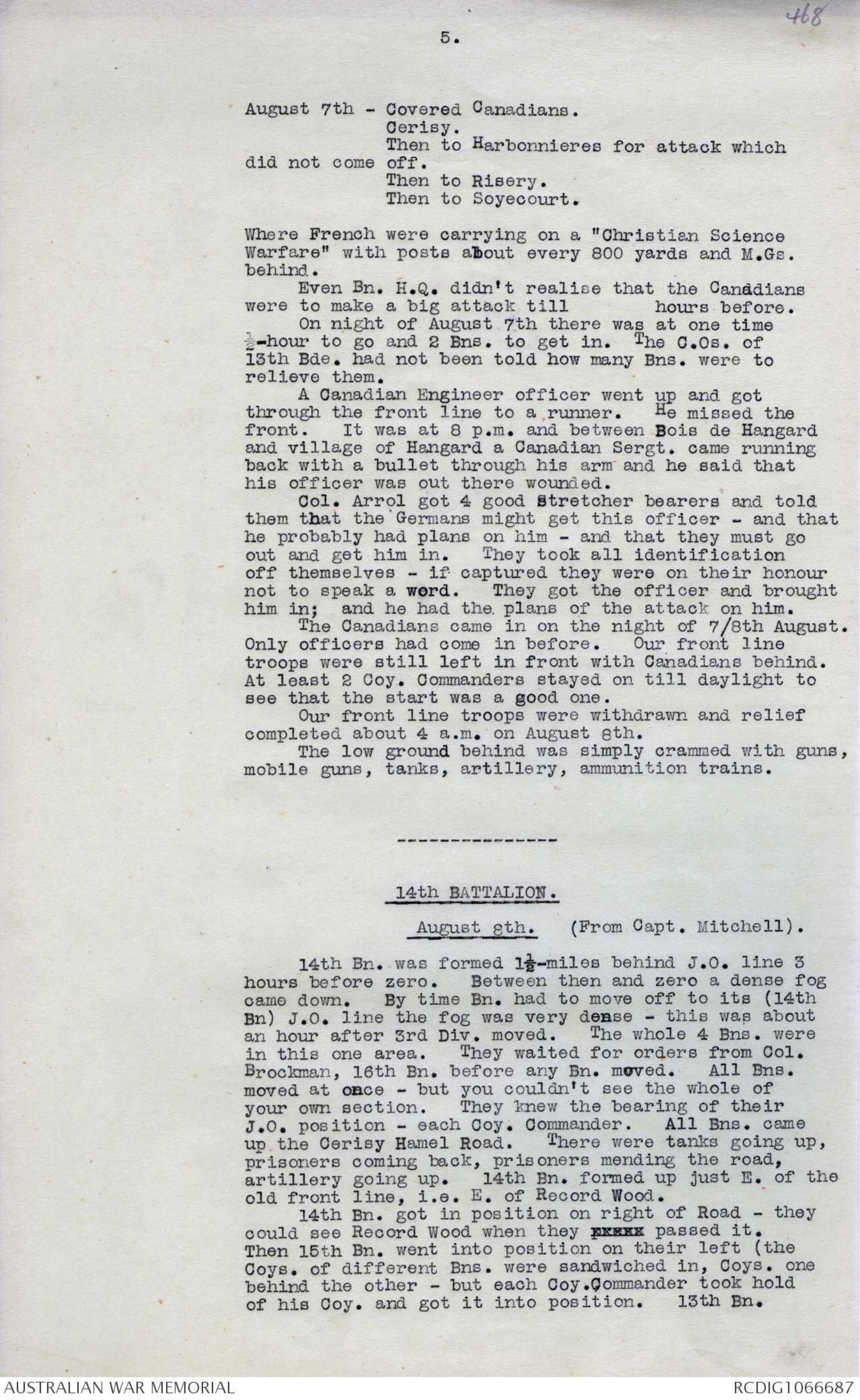
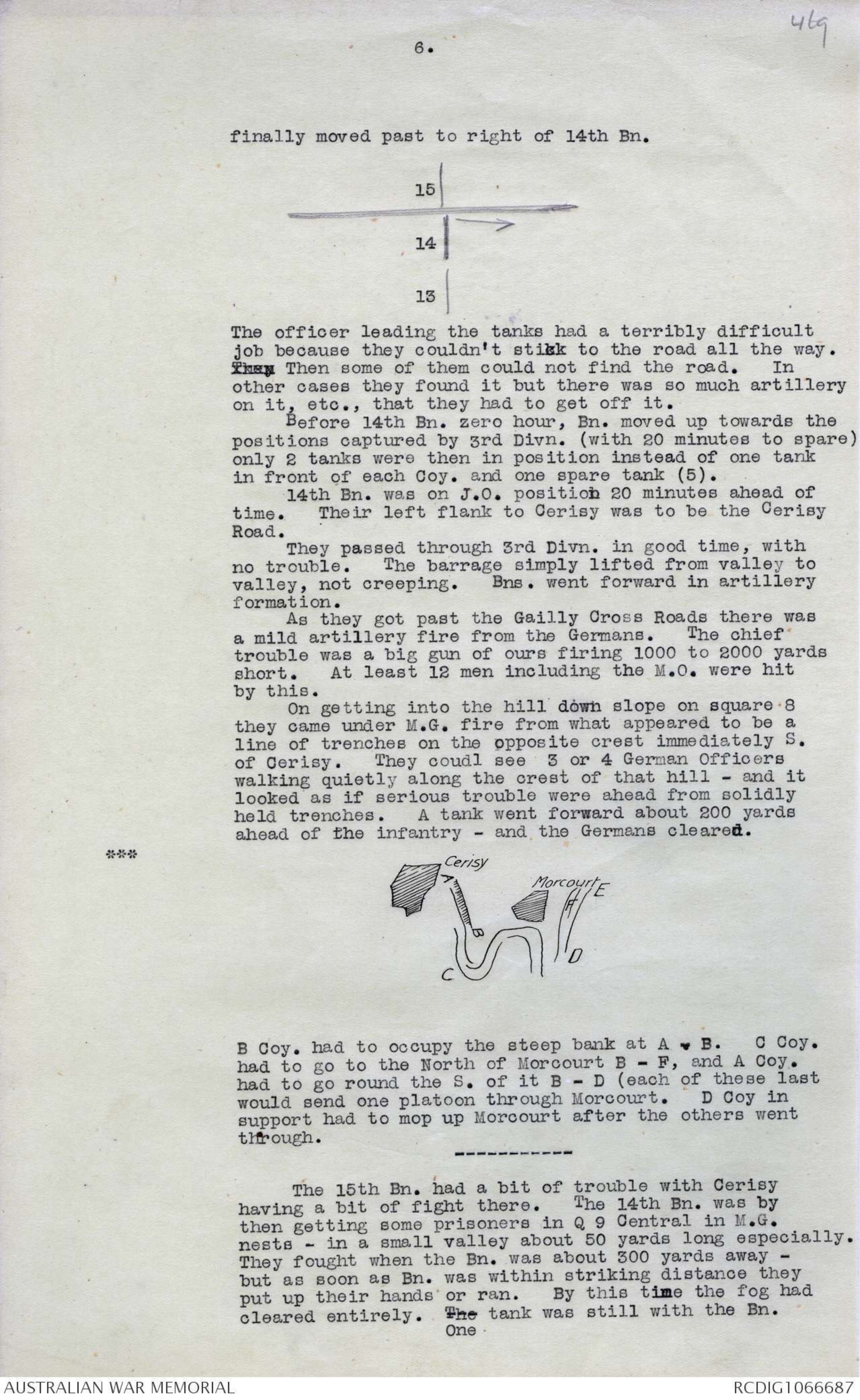
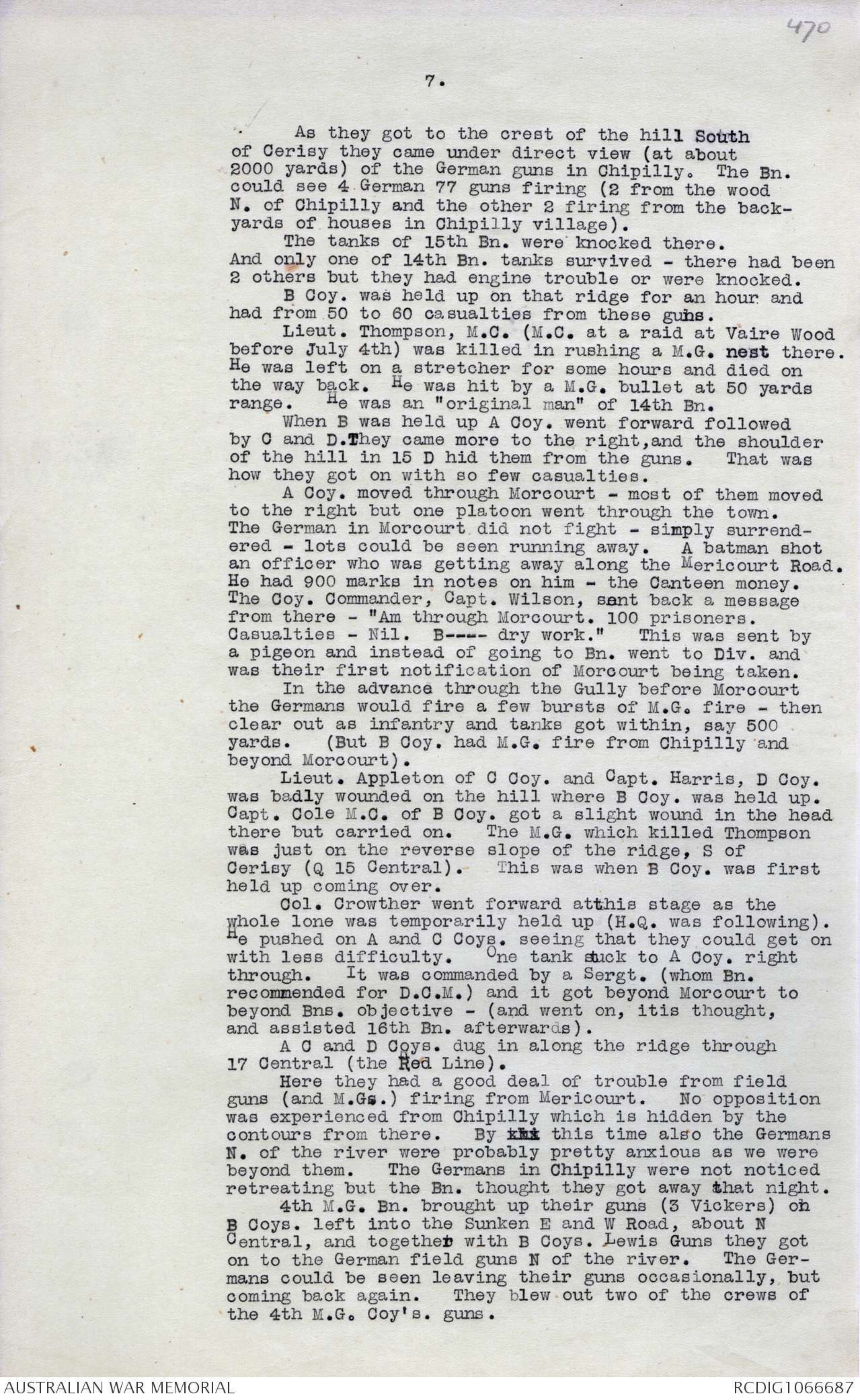
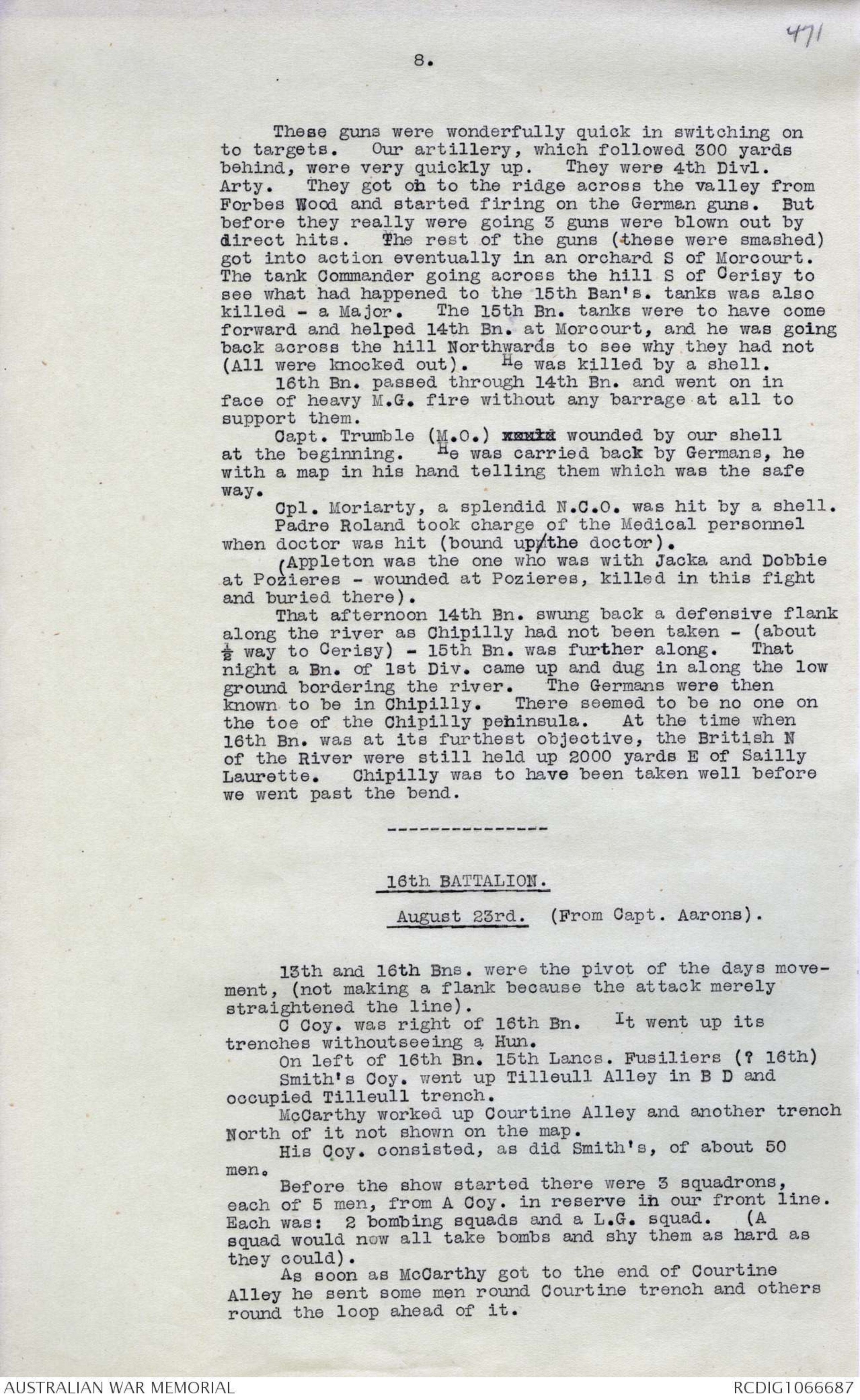
462
guides (This is our ordinary proceedure but it took
much longer).
On 15/16 the 49th Battalion was relieved by 34th
Battalion which had been under 13th Brigade. 13th Brigade
was to have gone in again - but this was cancelled.
3rd Division was brought across and 13th Battalion was
sent to rejoin 4th Division at Harbonnieres. An
American 132 Regiment had been attached to 4th Division;
The Americans were at this time all withdrawn and so the
13th Brigade was sent back as reserve to 4th Division
which had two Brigades in the line. They were in reserve
all the time at Lihons.
July 31st/
August 1st.This night 13th Brigade began to take
over from French. By August 6th they took over from
Domart (South of the Luce) to Villers Bretonneux.
Brigade told by Division on 31st July what was
going to happen. Col. Christie knew on the night of July
31st (and the other C.O's) They were just told that an
attack was coming off and dispositions for the next
4 nights. The nights of 1st and 2nd August everything
was all right. 31/1, and 1/2 51st had one Company in.
Night of 2/3 51 took over the line of right Company
of 49th Battalion which brought them North of the Luce,
one Company North and one South up to then the Germans.
had not shown that they had noticed any difference. The
machine gun company ran 3 G.S. waggons across the horizon
but undoubtedly our men would be more in sight than the
French. If the French saw you walking in sight in the
daylight they would fire a blank cartridge at you - they
fired at General Herring and their own General - a blank
cartridge to warn them to get off. This was the charming
old French Colonel Dozac who was showing them round he
had lost an arm at Verdun - "Oh it is nothing- it is just
the sentry fired a blank cartridge to keep us off the
road".
On night of 2/3 at 3.a.m. exactly the Germans put
down a heavy barrage on our front line and on the
villages of Hourges and Domart. He kept it on the front
line for 2 minutes and then lifted it onto Domart for
1/2 hour or more. He had, had an unsuccessful silent raid
exactly there on the French just before the 13th Brigade
took over. He was intending to make sure this time. They
attacked the centre platoon posts of the right Company,
South of the Luce. As soon as they got their heads up
they found the Germans on top of them. They tried to
fire their Lewis Guns, but one crew was bombed out and
the other gun jammed. He forced them back and got into
Hourges (20 or 30 ruined houses) Then he turned and went
back up the Roye road, and came on the left platoon of
right Company in the rear. They had a fight, very confused
Platoon Commander Lieut. Fryar was badly wounded by a shower
of stick bombs and Capt. Aruse was slightly wounded.
He stayed on. It was a very dark night and the platoon
found afterwards that 5 men were missing. Serteang Action,
platoon sergeant of this platoon - a first rate N.C.O., and
an intelligent man, was the sergeant. About 8 or 9
Germans were found dead there. We had about 20 casualties -
4 killed. Col. got one wounded German, who died - no
identification on him whatever - it was an organised raid.
463
A few Canadian engineer Officers had been about.
The ration parties might have noticed Canadians reconnoitring
in the rear areas (a representative of the Army Commandant
was there next morning - at the Battalion - asking if
anything had been known by our men. But it was pretty
certain our men knew nothing).
The German did not raid again. He settled down
again. For two nights the shelling was a little above
normal, we thought. But it was the sleepiest line the
division was ever in. There were not 10 other casualties
in the Brigade. 51st Battalion had no more. The
dugouts were splendid our trenches and the Germans were on
opposite slopes - you could see for miles any movement.
The trenches were good. They had a skeleton out
shead and the main line of resistance was 3000 yards
back. The French programme was to give up the front line and
put down their barrage on it.
On the night of 6/7 a Canadian Officer out pegging
the line was shot. The 13th Brigade was then holding
over 3000 yards of front with 1600 men and there were
gaps of several hundred yards. There was a very real
danger of visiting officers walking through. There was
an out post line in front ( The trenches had been dug by
the French. There were two ticklish nights when the
Brigade had this hugh front - One Division was now
behind each Battalion.
2 20
1. 49
3 51
3rd D.H.Q. took over 51st Battalion dugout. 4th Division
toom over 13th Brigade H.Q. dugout.
During these two nights there were 3 Companies in
each Battalion in the line and one in support (which was
ration carrying - all it could do). The Canandians were
in the support line. On the morning of August 8th the
50 Battalion was not quite out when the barrage came down
51st was out at 2.50 and 49 between the two (3.30 about)
They had not a casualty. The Germans was quieter that
night then the three previous nights. The Canadians
worked well with our people.
On 4th August 13th Brigade was under 4th Aust. Div.
" 4-7- under Canadian Corps.
" 8-9 Aust Corps.
" 10-12 4th Aust. Division.
" " 13-18 Liaison Force.
" 19 onwards 4th Aust. Division.
Mouquet Farm is the heaviest fight the 51st Battalion
was ever in. The shelling was much heavier than at
Villers Bretonneux. The sniping on the hill opposite
the Quarry was also very fierce.
464
14th BATTALION
Aug-Sept. 1918. (From Maj. Wadsworth)
16th BATTALION
Aug. 1918. (From Capt. Aarons)
Lihons.
Sept. 18.
Aug. 23. (From Lynas. Tanks from
Lynas).
15th BATTALION.
Sept. 18. 1918. (From Col. Johnston)
13th BRIGADE
Aug 6 and 7
Major Arrol 49th Bn.
diagram - refer to original
+Bannister 45th Bn. D.C.M., L.G. first held Germans
up here firing L.G. over trench from shoulder.
14th BATTALION.
August 17th. (From Maj. Wadsworth).
On this morning about noon 14th Bn. with 6th Bde. on
left and 13th Bn. on right went forward through trenches
about 600 yards and occupied lines of trenches E. of Madam
Wood. (about 25 yards E. of it). The Germans occupied these
trenches at night but not by day. Their rifles were loaded
on the parapet - numerous - and bombs by them. We meant to
wait for the Germans coming out that night. But they saw
us crossing some of the roads which went through the trenches.
The night following this attack (? 18/19th) the 2nd Div.
was relieved by 2nd Manchesters. The following morning about
10 a.m. the Germans raided the Manchesters. He put down a
Box Barrage. The British broke under this. The Germans
got up 3 C.Ts. at them and took prisoner practically the whole
front line of 2nd Manchesters. The prisoners were sent
back through the C.Ts. The left Coy. 14th Bn. during the
raid formed a defensive flank - and as soon as possible pushed
forward/
465
2.
forward into the front line till the 2nd Manchesters
could reorganise and take over again. The British
put up about 50 flares the night before and so the
Boche knew there was something doing:
The night of 20/21st 14th Bn. was relieved by
15th Bn.
19th BATTALION.
September 18th. (From Maj.Wadsworth who
led).
14th Bn. started from Morse Copse near Vraignes
at 12 midnight to old trenches near Vendelles.
They had breakfast there at 6 a.m. - it was raining
solidly at the time. Bn. moved at 7.15 from
Vendelles. It skirted Jeancourt, Long Copse, and
Leverguier, and took up a position on the road
running on our side of the hill at Priel Copse - just
in rear of the red line
B C
D A
They then moved up the slope to the red line while
the protective barrage was playing in front.
Grand Priel Farm was suffering from 2 whizzbang
guns which were finally found (you could see from the
Red line the men manning the guns) on the parapet
(German Parado) of the final objective. (The Bn.
for this reason skirted Priel Farm).
As soon as the protective barrage on the red
line ceased the two front Coys. moved forward. It
was beautifully fine. They had not moved 10 yards
before they began to get casualties from German M.Gs.
firing from the Hindenburg Out Post Line. Bn. was
in lines when it started from the red line (itbwas
a huge front of about 1800 yards at the tail end of
the fight and the Bn. only took xxxx 389 men over.
By the time the front Coys. had got down into
the bottom of the valley they were so few and weak
that it was decided to bring the other two Coys.
into line. There was no artillery fire on our side
at all, and no M.G. covering fire. In Big and Little
Bill, on the left of the Bn. immediately in rear of
Ascension Wood and up the slope towards the German
Outpost Line the Germans at first were firing with
2 or 3 M.Gs. in small bursts. It was decided to
bring the two support Coys. into Line - they were
about 250 yards in rear coming along in artillery
formation. When they got up, our L.Gs. were put
on to the Copses - Big and Little Bill and the Germans
ran from these up the slope back to their own lines -
they were seen - 3 or 3 men - dodging back.
At this time 10th Bn. right and 14th Bn. left
Coys. were held up by M.G. fire for a considerable
time - up to 1 1/2-hours. As soon as ever you showed
your head over a slope you were xxxxx fired on by
several guns. The left of 73rd Bde. had got in
under the barrage. Right of 13th Bn. got into the
Sunken Road in 26 B. and D. and dug in there for the
time being (the road runs through the German wire on
the right).
The 3rd Bde, was just gettingnin at this time on
left of 14th Bn.
466
3.
At this time Maj. Wadsworth and several officers
had a consultation in thevalley and decided that it
was no use attempting with so few men and no artillery
to go over the top against such wire. It was decided
to send one Coy. up a Gully on the left and through
3rd Bde. area into trenches to bomb down to the right.
Immediately after this another Coy, was to go through
them and take up the bomb fight - at the same time
bombing forward to gain the second line of trenches.
2 Coys. were put into the line (about midday)
and they bombed down about 300 yards and there struck
a very scientifically constructed German block.
We tried to pass it - and lost one man killed and 7
wounded. The end of the trench which we had on the
left of this block was about 50 yards of straight
trench, very low, and the German had a M.G. pointing
down it. Accordingly we withdrew and made a bomb
block.
It was now decided that they should hold fast
till dusk and then after dusk the 2 Coys. from the
Sunken Road should be brought into the trenches
occupied. This gave 4 Coys. in a trench of 300 yards
long. It was then decided further to put down a
barrage at 11 p.m. on (1) the trench to the right of
our bomb block, and (2) the trench ahead (German
Support Line).
The 4 Coys. would line up in the 400 yards, 2
deep in the trench
diagram - refer to original
After the 5 minutes barrage on the German front line
A Coy. was immediately to bomb down to the right.
D Coy. eased out to right and kept touch with A Coys.
left.
B and C Coys. went out straight to the front and got
as close as possible to the German Support Line.
(This was the only thing to do as the wire exactly
in front was very light whereas further to the right
it was very heavy.
A Coy, moved off down the trench 5 minutes
ahead of the others. The Germans ran out of that
trench into the trench in rear. A Coy. caught with
bombs good few (12 dead in one day, 2 wounded and 2
unwounded) (6 bombs).
As soon as C Coy. got to the front line, they
began to bomb to the right, keeping touch and time
with A Coy. which was working parrallel.
B Coy. bombed to the left and obtained touch
with 10th Bn. on the left.
It was between 2 and 3 a.m. that 14th Bn. got
touch with 46th Bn. (who attacked the trench on their
front at 11 p.m. also). The 14th had to bomb down
900 yards of trench - It was good deep trench, with
very deep dugouts and plenty of them. The wire on
the front where C and B attacked it had been broken in
some earlier fight. Where it had been passed before
getting into the front line, that afternoon, the wire
had been very heavy.
The Bn. got about 50 prisoners but there were a
great number of dead mostly in the dugouts, and there
were 12 dead Germans in the little straight bit of
trench near the bomb block. The Germans were
probably driven over into 46th Bn. area or out to the
Hindenburg Line in rear.
Next morning, when the light broke a beautiful
view opened out. No artillery man was up there for
467
4.
24 hours. The German was moving his guns even on
our side of the Canal - he was trying to shift big
guns with lorries and with horses. The infantry
managed to stop this by using the Germans own M.G.
- 15 guns (of about 50) were mounted for defence with
20,000 rounds of ammunition. During the day 7 - 77s,
and 2 - 4.2 H.V. guns and some T.Ms. were captured -
2 antitank rifles - (the guns on the parapet were
77s. of the old type - and it was they which had been
firing at Grand Priel Farm.
Lt. Garton wounded in leg on going up the slope
towards the Sunken Road.
Lt. Ebbott wounded in chest about the same time.
About 100 O.R. were killed and wounded in the
same fight.
An attempt was made to get C Coy. into the line
occupied by B Coy. by daylight. They had to go back
round the West end of Ascension Wood and up the Valley
whore B Coy. had gone. About 12 men were dribbled
through. But the German was sniping at about 200
yards and there was too great a loss - Several of the
12 were hit - so it was decided to stop till dusk, and
go round the same way together with A Coy.
Maj. Wadsworth's life was saved that day by an
issue watch. 14th Bn. H.Q. was in the big dugout
just E. of Grand Priel Farm. 14th Bn. exploitation
was over the whole front - they passed through 15th
Bn and 13th Bn.
The march up was carried out as follows: Their
route lay between Primal Wood and Le Verguier and then
past Long Copse. As they came up towards Le Verguier
they could see that the German was shelling this space
very heavily. They decided to wheel left and go
round the left ov Primal Wood. This absolutely
avoided the shelling and no casualties were suffered.
The decision to avoid an area like this Wood lie with
whoever was loading the Bn. through. The Int. Offr.
and Maj. Wadsworth wore loading and they simply led
off to the left (this is the way things are done nowadays
as compared with the old way). Col. Crowther noticed
that Bn. was off its line and sent up to ask why (he
was in the Column when he heard he immediately agreed).
13th BATTALION.
In the mist that day 13th Bn. H.Q. found themselves
in a fight and had to bomb a German Post.14th Bn.
going forward later had no difficulty with the mist
at all
Before 4th Bde. went into the line the 13th Bde.
had got this J.O. line by peaceful penetration.
13th BRIGADE.
August 6th and 7th. (From Col. Arrol)
468
5.
August 7th - Covered Canadians.
Cerisy.
Then to Harbonnieres for attack which
did not come off.
Then to Risery.
Then to Soyecourt.
Where French were carrying on a "Christian Science
Warfare" with posts about every 800 yards and M.Gs.
behind.
Even Bn. H.Q. didn't realise that the Canadians
were to make a big attack till hours before.
On night of August 7th there was at one time
1/2-hour to go and 2 Bns. to get in. The C.Os. of
13th Bde. had not been told how many Bns. were to
relieve them.
A Canadian Engineer officer went up and got
through the front line to a runner. He missed the
front. It was at 8 p.m. and between Bois de Hangard
and village of Hangard a Canadian Sergt. came running
back with a bullet through his arm and he said that
his officer was out there wounded.
Col. Arrol got 4 good Stretcher bearers and told
them that the Germans might get this officer - and that
he probably had plans on him - and that they must go
out and get him in. They took all identification
off themselves - if captured they were on their honour
not to speak a word. They got the officer and brought
him in; and he had the plans of the attack on him.
The Canadians came in on the night of 7/8th August.
Only officers had come in before. Our front line
troops were still left in front with Canadians behind.
At least 2 Coy. Commanders stayed on till daylight to
see that the start was a good one.
Our front line troops were withdrawn and relief
completed about 4 a.m. on August 8th.
The low ground behind was simply crammed with guns,
mobile guns, tanks, artillery, ammunition trains.
14th BATTALION.
August 8th. (From Capt. Mitchell).
14th Bn. was formed 1 1/2-miles behind J.0. line 3
hours before zero. Between then and zero a dense fog
came down. By time Bn. had to move off to its (14th
Bn) J.O. line the fog was very dense - this was about
an hour after 3rd Div. moved. The whole 4 Bns. were
in this one area. They waited for orders from Col.
Brockman, 16th Bn. before any Bn. moved. All Bns.
moved at once - but you couldn't see the whole of
your own section. They knew the bearing of their
J.O. position - each Coy. Commander. All Bns. came
up the Cerisy Hamel Road. There were tanks going up,
prisoners coming back, prisoners mending the road,
artillery going up. 14th Bn. formed up just E. of the
old front line, i.e. E. of Record Wood.
14th Bn. got in position on right of Road - they
could see Record Wood when they xxxxx passed it.
Then 15th Bn. went into position on their left (the
Coys. of different Bns. were sandwiched in, Coys. one
behind the other - but each Coy.Commander took hold
of his Coy. and got it into position. 13th Bn.
469
6.
finally moved past to right of 14th Bn.
15
14
13
The officer leading the tanks had a terribly difficult
job because they couldn't stick to the road all the way.They Then some of them could not find the road. In
other cases they found it but there was so much artillery
on it, etc., that they had to get off it.
Before 14th Bn. zero hour, Bn. moved up towards the
positions captured by 3rd Divn. (with 20 minutes to spare)
only 2 tanks were then in position instead of one tank
in front of each Coy. and one spare tank (5).
14th Bn. was on J.O. position 20 minutes ahead of
time. Their left flank to Cerisy was to be the Cerisy
Road.
They passed through 3rd Divn. in good time, with
no trouble. The barrage simply lifted from valley to
valley, not creeping. Bns. went forward in artillery
formation.
As they got past the Gailly Cross Roads there was
a mild artillery fire from the Germans. The chief
trouble was a big gun of ours firing 1000 to 2000 yards
short. At least 12 men including the M.O. were hit
by this.
On getting into the hill down slope on square 8
they came under M.G. fire from what appeared to be a
line of trenches on the opposite crest immediately S.
of Cerisy. They coudl see 3 or 4 German Officers
walking quietly along the crest of that hill - and it
looked as if serious trouble were ahead from solidly
held trenches. A tank went forward about 200 yards
ahead of the infantry - and the Germans cleared.
diagram - refer to original
B Coy, had to occupy the steep bank at A - B. C Coy.
had to go to the North of Morcourt B - F, and A Coy.
had to go round the S. of it B - D (each of these last
would send one platoon through Morcourt. D Coy in
upport had to mop up Morcourt after the others went
through.
The 15th Bn. had a bit of trouble with Cerisy
having a bit of fight there. The 14th Bn. was by
then getting some prisoners in Q 9 Central in M.G.
nests - in a small valley about 50 yards long especially.
They fought when the Bn. was about 300 yards away -
but as soon as Bn. was within striking distance they
put up their hands or ran. By this time the fog had
cleared entirely. The One tank was still with the Bn.
470
7.
As they got to the crest of the hill South
of Cerisy they came under direct view (at about
2000 yards) of the German guns in Chipilly. The Bn.
could see 4. German 77 guns firing (2 from the wood
N. of Chipilly and the other 2 firing from the back-
yards of houses in Chipilly village).
The tanks of 15th Bn. were knocked there.
And only one of 14th Bn. tanks survived - there had been
2 others but they had engine trouble or were knocked.
B Coy, was held up on that ridge for an hour and
had from 50 to 60 casualties from these guns.
Lieut. Thompson, M.C. (M.C. at a raid at Vaire Wood
before July 4th) was killed in rushing a M.G. nest there
He was left on a stretcher for some hours and died on
the way back. He was hit by a M.G. bullet at 50 yards
range. He was an "original man" of 14th Bn.
When B was held up A Coy, went forward followed
by C and D.They came more to the right,and the shoulder
of the hill in 15 D hid them from the guns. That was
how they got on with so few casualties.
A Coy. moved through Morcourt - most of them moved
to the right but one platoon went through the town.
The German in Morcourt did not fight - simply surrendered
- lots could be seen running away. A batman shot
an officer who was getting away along the Mericourt Road.
He had 900 marks in notes on him - the Canteen money.
The Coy. Commander, Capt. Wilson, sent back a message
from there - "Am through Morcourt. 100 prisoners.
Casualties - Nil. B---- dry work." This was sent by
a pigeon and instead of going to Bn. went to Div. and
was their first notification of Morcourt being taken.
In the advance through the Gully before Morcourt
the Germans would fire a few bursts of M.G. fire - then
clear out as infantry and tanks got within, say 500
yards. (But B Coy, had M.G. fire from Chipilly and
beyond Morcourt).
Lieut. Appleton of C Coy. and Capt. Harris, D Coy.
was badly wounded on the hill where B Coy, was held up.
Capt. Cole M.C. of B Coy. got a slight wound in the head
there but carried on. The M.G. which killed Thompson
was just on the reverse slope of the ridge, S of
Cerisy (Q 15 Central). This was when B Coy, was first
held up coming over.
Col. Crowther went forward atthis stage as the
whole lone was temporarily held up (H.Q. was following).
He pushed on A and C Coys. seeing that they could get on
with less difficulty. One tank suck to A Coy. right
through. It was commanded by a Sergt. (whom Bn.
recommended for D.C.M.) and it got beyond Morcourt to
beyond Bns. objective - (and went on, itis thought,
and assisted 16th Bn. afterwards).
A C and D Coys. dug in along the ridge through
17 Central (the Red Line).
Here they had a good deal of trouble from field
guns (and M.Gs.) firing from Mericourt. No opposition
was experienced from Chipilly which is hidden by the
contours from there. By xxx this time also the Germans
N. of the river were probably pretty anxious as we were
beyond them. The Germans in Chipilly were not noticed
retreating but the Bn. thought they got away that night.
4th M.G. Bn. brought up their guns (3 Vickers) on
B Coys. left into the Sunken E and W Road, about N
Central, and together with B Coys. Lewis Guns they got
on to the German field guns N of the river. The Germans
could be seen leaving their guns occasionally, but
coming back again. They blew out two of the crews of
the 4th M.G. Coy's. guns.
471
8.
These guns were wonderfully quick in switching on
to targets. Our artillery, which followed 300 yards
behind, were very quickly up. They were 4th Divl.
Arty. They got on to the ridge across the valley from
Forbes Wood and started firing on the German guns. But
before they really were going 3 guns were blown out by
direct hits. The rest of the guns (these were smashed)
got into action eventually in an orchard S of Morcourt.
The tank Commander going across the hill S of Cerisy to
see what had happened to the 15th Ban's. tanks was also
killed - a Major. The 15th Bn. tanks were to have come
forward and helped 14th Bn. at Morcourt, and he was going
back across the hill Northwards to see why they had not
(All were knocked out). He was killed by a shell.
16th Bn. passed through 14th Bn. and went on in
face of heavy M.G. fire without any barrage at all to
support them.
Capt. Trumble (M.O.) xxxxx wounded by our shell
at the beginning. He was carried back by Germans, he
with a map in his hand telling them which was the safe
way.
Cpl. Moriarty, a splendid N.C.O. was hit by a shell.
Padre Roland took charge of the Medical personnel
when doctor was hit (bound upmthe doctor).
(Appleton was the one who was with Jacka and Dobbie
at Pozieres - wounded at Pozieres, killed in this fight
and buried there).
That afternoon 14th Bn. swung back a defensive flank
along the river as Chipilly had not been taken - (about
1/2 way to Cerisy) - 15th Bn. was further along. That
night a Bn. of 1st Div. came up and dug in along the low
ground bordering the river. The Germans were then
known to be in Chipilly. There seemed to be no one on
the toe of the Chipilly peninsula. At the time when
16th Bn. was at its furthest objective, the British N
of the River were still held up 2000 yards E of Sailly
Laurette. Chipilly was to have been taken well before
we went past the bend.
16th BATTALION.
August 23rd. (From Capt. Aarons).
13th and 16th Bns, were the pivot of the days movement,
(not making a flank because the attack merely
straightened the line).
Coy, was right of 16th Bn. It went up its
trenches withoutseeing a Hun.
On left of 16th Bn. 15th Lancs. Fusiliers (? 16th)
Smith's Coy, went up Tilleull Alley in B D and
occupied Tilleull trench.
McCarthy worked up Courtine Alley and another trench
North of it not shown on the map.
His Coy. consisted, as did Smith's, of about 50
men.
Before the show started there were 3 squadrons,
each of 5 men, from A Coy. in reserve in our front line.
Each was: 2 bombing squads and a L.G. squad. (A
squad would now all take bombs and shy them as hard as
they could).
As soon as McCarthy got to the end of Courtine
Alley he sent some men round Courtine trench and others
round the loop ahead of it.
 Sam scott
Sam scottThis transcription item is now locked to you for editing. To release the lock either Save your changes or Cancel.
This lock will be automatically released after 60 minutes of inactivity.